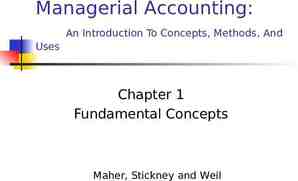DW Toolkit Chapter 1 Defining Business Requirements
21 Slides87.50 KB
DW Toolkit Chapter 1 Defining Business Requirements
DW Lifecycle Project Planning Business Requirements Definition Technical Architecture Design Product Selection & Installation Dimensional Modeling Physical Design BI Application Specification Growth ETL Design & Development BI Application Development Project Management Deployment Maintenance
Goal: Enhance Business Value Technology is important; business value is mandatory. Recruit strong sponsorship Define enterprise-level business requirements Prioritize business requirements Plan the project Define project-level business requirements
Sponsorship Business sponsors (more than one) take a lead role in determining the purpose, content, and priorities of the DW/BI system. Visionary: sense the value with some idea of how to apply it Resourceful: can obtain resources and effect organizational change Reasonable: balance enthusiasm with an understanding of needed time and resources
Gathering Enterprise-Level Requirements Prepare Conduct Business Interviews Conduct IT Interviews Write up Interview Summaries Identify Business Processes Build Initial Bus Matrix Conduct Prioritization Session Write Requirements Definition Use Data Profiles to Research Data Sources
The interview process The Conduct Business Interviews Conduct IT Interviews Write up Interview Summaries Identify Business Processes Build Initial Bus Matrix Interview Documentation Themes and processes The bus architecture
What do you want to know? What is the problem area? How does the business you approach it? Is the data available? Who will use the results? Who cares?
Subjects Business Executive What are the business issues? What is your vision? Business Manager or Analyst (pp. 116 – 117) What are your measures of success? What data do you use? What analysis do you typically do? Data Audit Data quality or quantity issues? Potential roadblocks (political or technical)? How is ad hoc analysis conducted?
Results of the interviews Analytic themes and business goals Themes: fundamental questions that the business wants answered Goals: state that the business aspires to Business processes: sources of data to support analytic themes Dimensions: entities or categories that define the themes Business value: how much is solving the problem worth
Interviews Individual or group Roles Lead Interviewer Scribe Pre-interview research Questionnaire Agenda User Preparation Write-up
Interview Roles Lead Interviewer(s): Scribe: direct the questions and adapt to the conversation take notes. interject if the lead interviewer misses something. write up the session Observer (not more than two) observe – not participate
The interview process Introduce everyone: make everyone feel comfortable. Introduce the subject Remember your role Verify communication Define terminology Establish peer basis: know interviewees vocabulary and business understanding
The interview process (cont.) Be flexible Avoid burnout be prepared to schedule additional interviews respect your interviewees time and reschedule if needed don’t schedule too many at once leave time between sessions Manage Expectations
The interview process (cont.) Wrap up the interview Summarize Ask for permission to call back Get documentation Write up the interview soon (2 hours to 2 days)
Tape recorders Cannot really replace people Ask first May make subjects nervous Require listening to the meeting twice
Facilitated sessions Each one takes more time than interviews, but may generate more Requires an experienced facilitator Requires an initial understanding of the user area Participants feed of of each others ideas Participants can negotiate disagreements
Caveats The one question to never ask is “What do you want in your computer system?” That is your job, not theirs. You need to be brave enough to ask executives what keeps them up at night? The interview team needs to resist the temptation to focus only on the top 5 reports or top ten questions. Continually manage expectations.
Bus Matrix Process Dat e Produc Vendor Shippe Dist t r Cntr Store Promo Purchase Orders X X X Dist Cntr Deliveries X X X Dst Cntr Inventory X X Store Deliveries X X Store Inventory X X X Store Sales X X X X X X X X X X X
Requirements Findings Document (Business Case) Establishes the relevance and credibility of the data warehouse project. Ties the business requirements to the realistic availability of data.
Prioritization High Stars Business Value Dogs Low Low Feasibility High
Initial Project High value Strong sponsorship Low difficulty Moderately visible Single data source


























